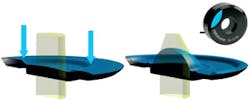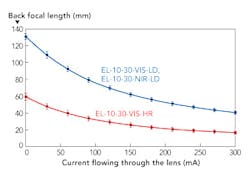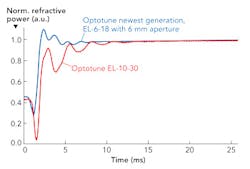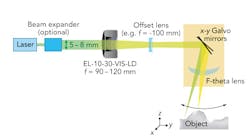Selina Pekarek and Mark Blum
Controlling a beam focus with an electrically tunable lens enables a faster, more compact, reliable laser system
In standard laser material processing applications, axial focusing is achieved with mechanical translation stages that move either the optics or the workpiece, an approach that exhibits limitations concerning speed, reliability, and equipment costs. Instead of using complex mechanics, the z-position (vertical) of a beam focus can be controlled by using a lens with an electrically tunable focus. This allows for fast response times (in the range of milliseconds), enabling high-speed processing and fast switching between targets. Furthermore, because of the reduced number of moving parts, the overall system can be made more compact and reliable. A tunable-lens technology developed by Optotune is now successfully used in applications such as laser marking, engraving, and surface preparation.
Working principle of the tunable lens
Optotune’s electrically tunable lens is a shape-changing lens. The core of the lens consists of a container filled with an optical fluid and sealed off with an elastic polymer membrane. An electromagnetic actuator integrated into the lens controls a ring that exerts pressure on the container (FIGURE 1). The deflection of the lens depends on the pressure in the fluid; therefore, the focal length of the lens can be controlled by current flowing through the coil of the actuator. The aperture of Optotune’s EL-10-30 lens is 10 mm and the focal length can be varied between 20–120 mm (FIGURE 2). The voltages required to cover the complete tuning range are small (<5 V). The lens does not exhibit hysteresis and the performance of the lens is not sensitive to different polarizations. Moreover, the electrically tunable lenses enable novel applications due to their short response times in the range of milliseconds (FIGURE 3). Additionally, the membrane is long-term stable and the lens can be operated over more than 10 million lifecycles.
A challenge for the lens is gravity, which can induce a coma when the lens is used in upright position (horizontal optical axis). Therefore, it is recommended that the optical system be designed with the lens in lying position (vertical optical axis). Recent optimization of the membrane’s mechanical properties has reduced this issue, however, so that the lens is also suitable for high-precision applications.
Damage and control
Lenses from Optotune, made of low-dispersion material, exhibit very low absorption in the wavelength range from 250–2000 nm. Tests have been performed with both continuous wave (cw) and pulsed laser sources. The cw laser source tested emitted at a wavelength of 1070 nm with an output power of 200 W and a beam diameter of 3 mm, yielding a damage threshold of at least 2.2 kW/cm2. Using a pulsed laser operating at 1064 nm, with a pulse duration of 20 ns at a repetition rate of 50 kHz, an average power of 10 W was focused onto the tunable lens; with a spot size of 50 µm, this yielded an energy density of 10 J/ cm2. Up to these levels, the lens did not show any sign of damage. The effective damage threshold could not be determined because of the limited power of the available test sources.
At high intensities, the residual absorption can heat up the lens, at which point the fluid expands and the focusing behavior of the lens might change. However, the tunable lens can be easily remotely controlled, so an even higher-precision and temperature-independent operation can be achieved by using an optical feedback system.
Applications
Focus tunable lenses are a novel platform technology for many applications. In imaging, the lenses are used for fast focus control and zoom, for example in machine vision, microscopy, or camera phones. In illumination systems, the lenses provide a compact and efficient way to control divergence (such as an LED spotlight).
The high damage thresholds of the tunable lenses also open up a wide range of applications in laser processing. Good results have already been obtained in marking, 3D engraving, and surface preparation, and the same is expected for micromachining and drilling. In principle, even high-power applications such as cutting and welding should be possible. An example of a setup for 3D laser marking is described in more detail in the next section.
3D laser processing
FIGURE 4 shows an ideal layout for a 3D laser processing system with an electrically tunable lens, galvonometer mirrors, and an F-Theta lens. The beam size of the laser can be adapted by an optional beam expander if required. The optical system consists of a combination of a tunable lens and a fixed concave lens, with the electrically tunable lens a converging lens. Negative focal length can be achieved in combination with an offset lens. Therefore, by changing the focal length of the tunable lens, the divergence angle after the two lenses is varied. In combination with the focusing lens at the end of the optical system, this results in an adjustment of the z-position of the focus of about 150 mm. Only the current applied to the tunable lens has to be changed for this adjustment. By contrast, in a traditional setup either a lens or the object plane has to be mechanically translated, a procedure usually accompanied by less precision which is time consuming and less reliable.
After the two lenses, the propagation direction of the beam is controlled with galvo mirrors. In combination with an F-Theta lens, the beam can be focused everywhere on the x-y-plane with a good spot quality. With the described setup, the position of the focus can be controlled in all three directions with a minimal amount of mechanics and at high speed.
Conclusion
The tunable lenses described are suitable for high-power applications and can thus offer a means for faster and more reliable focusing in laser processing. These lenses are especially suited to replace the traditional mechanical units for adjusting the z-position of the focus with high precision and reliability. Furthermore, as a consequence of their fast response times, they allow fast switching in the range of milliseconds. ✺
Dr. Selina Pekarek ([email protected]) is an applications engineer, and Mark Blum is corporate operations officer (COO), at Optotune AG, Dietikon, Switzerland (www.optotune.com).
More Industrial Laser Solutions Current Issue Articles
More Industrial Laser Solutions Archives Issue Articles



